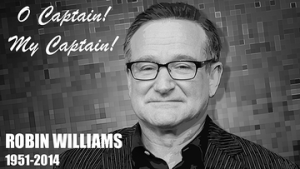O Captain, my Captain! Our fearful trip is done,
The ship has weathered every rack, the prize we sought is won,
The port is near, the bells I hear, the people all exulting,
While follow eyes the steady keel, the vessel grim and daring;
But O heart! heart! heart!
O the bleeding drops of red,
Where on the deck my Captain lies,
Fallen cold and dead.
O Captain! My Captain! Rise up and hear the bells;
Rise up–for you the flag is flung for you the bugle trills,
For you bouquets and ribboned wreaths for you the shores a-crowding,
For you they call, the swaying mass, their eager faces turning;
Here Captain! dear father!
This arm beneath your head!
It is some dream that on the deck,
You’ve fallen cold and dead.
My Captain does not answer, his lips are pale and still;
My father does not feel my arm, he has no pulse nor will;
The ship is anchored safe and sound, its voyage closed and done;
From fearful trip the victor ship comes in with object won;
Exult O shores, and ring O bells!
But I, with mournful tread,
Walk the deck my Captain lies,
Fallen cold and dead.
***
Robin Williams’ death affected me more than I can say. He was a comedic genius whose comedy style really struck a chord with me in the 1970s and since. He and I shared a love of Jonathan Winters – I used to emulate Winters’ routine of putting on various hats and improving a bit based on the hat. Robin Williams would do that in his routines, too,
I did not react with this much emotion even with John Lennon – it was just as shocking but I was only a kid of 16 and did not have the maturity yet to realize the tremendous loss we all suffered. George Harrison’s death was sad, but he suffered and his passing was an end to his pain. Bob Hope’s death – well, he lived SUCH a full life his passing, although sad, was not surprising. Anticipated but still not expected. These were the words my dad used to describe the death of my mother.
I hope Robin Williams’ death brings depression and other mental diseases to the fore. It looks like it already has. Suicide Prevention hotlines are already littering Facebook walls with his photo. If any good can come of his death … let’s hope this will.
Deepest condolences to his family and friends. And to all of us.
***
From USA Today 8/2/14:
Advocates for people with mental illness say they hope Williams’ death will motivate more people to get help for depression, and spur the USA to treat suicide as a public health crisis. Suicide claims more than 38,000 American lives each year — more than the number killed by car accidents, according to the Centers for Disease Control and Prevention — and the rate hasn’t budged in decades, says Jeffrey Lieberman, professor and chairman of psychiatry at New York’s Columbia University College of Physicians and Surgeons
“We know what to do to prevent suicide,” Liebeman says. “We just don’t do it.”
Williams could put a human face on a problem that often gets little attention, Lieberman says.
“He was such a charismatic and beloved figure, that if his death can galvanize our society to act instead of just grieve, it will be a fitting memorial to him.”
Contributing: Liz Szabo
Some numbers on suicide:
– 39,518 people died by suicide in the U.S. (2011)
– 108.3 per day
– 1 person every 13.3 minutes
– 3.6 male deaths for each female death by suicide
Comparison to other highly publicized causes of death per year:
- Homicide 16,238
- Prostate Cancer 32,050
- Motor Vehicle Accidents 35,303
- Suicide 39,518
- Breast Cancer 39,520
By age:
Middle age (45-64 years): 18.6 per 100,000,
Elderly: 15.3 per 100,000
Teens (15-24) is 11 per 100,000.
(The rate for middle aged has been increasing and surpassed the rate for elderly a few years ago.)
Source: American Association of Suicidology
The national suicide prevention lifeline can be reached at 1-800-273-8255 or http://www.suicidepreventionlifeline.org
***
Here is an excellent blog describing his thoughts on suicide. I enjoyed it and hope you do to. I had some trouble getting this hyperlink to load; I hope you do not have such problems. I did NOT receive permission from the blogger to link their post – I hope they don’t mind.
http://m.blogher.com/what-suicide-isn-t-rip-robin-williams
Michael Curry




